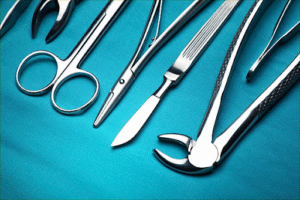
When you hear “wisdom teeth removal,” you might automatically think of a complex surgery. But is wisdom teeth removal always considered surgery? The truth is, it depends on how your wisdom teeth are positioned in your mouth. While many wisdom teeth extractions are indeed surgical, some are more straightforward. At Smiles for Health DDS, we distinguish between simple vs. surgical extractions based on complexity, ensuring you get the most appropriate and comfortable treatment for your needs.
Here’s the difference between simple and surgical extractions:
- Simple Extraction:
- This applies when the wisdom tooth has fully erupted through the gum line and is easily visible in your mouth.
- Our dentist can typically grasp the tooth with forceps and gently loosen it from its socket, usually in one piece.
- It’s a less invasive procedure, often performed under local anesthesia (just numbing the area), similar to getting a dental filling.
- Recovery is usually quicker, with less swelling and discomfort compared to surgical extraction.
- While still a dental procedure, this type of removal is generally not classified as full-blown “oral surgery” in the same way an impacted tooth removal is.
- Surgical Extraction:
- This is required when the wisdom tooth is impacted – meaning it’s stuck beneath the gum line, partially erupted, or angled awkwardly within the jawbone.
- To access the tooth, our dentist or oral surgeon needs to make an incision in the gum tissue.
- Sometimes, a small amount of bone covering the tooth might need to be removed.
- Often, the tooth itself needs to be divided into smaller pieces to be removed safely and efficiently, reducing trauma to the surrounding area.
- This procedure is more invasive and may require different types of sedation, from local anesthesia with nitrous oxide (laughing gas) or oral sedation, to IV sedation for deeper relaxation or general anesthesia where you are asleep.
- Recovery from a surgical extraction is typically longer, with more noticeable swelling, pain, and activity restrictions.
So, while any tooth removal is an “extraction,” whether it’s classified as “surgery” depends on whether incisions, bone removal, or tooth sectioning are necessary. The majority of wisdom tooth removals, especially for impacted teeth, do fall under the category of surgical extractions. Our team at Smiles for Health DDS will always perform a thorough examination, including X-rays, to determine the exact nature of your wisdom teeth and recommend the most appropriate procedure, guiding you every step of the way in your wellness dentistry journey.
What Happens During Surgical Wisdom Tooth Removal?
If you’ve been told you need a surgical wisdom tooth removal, it’s natural to feel a bit apprehensive and wonder, “What happens during surgical wisdom tooth removal?” Knowing the step-by-step process can help ease your mind. At Smiles for Health DDS, we ensure our patients are well-informed about every stage of their dental extractions so you know exactly what to expect.
Here’s a step-by-step guide to the procedure:
- Anesthesia and Sedation:
- First, we’ll make sure you’re comfortable. This usually starts with a local anesthetic injection to numb the area around your wisdom tooth, so you won’t feel any pain during the procedure itself.
- Depending on the complexity of the extraction and your comfort level, we might also use nitrous oxide for mild relaxation, oral sedation (a pill to help you relax), or IV sedation for deeper relaxation where you’ll be in a “twilight sleep” and likely have little to no memory of the procedure. For very complex cases or patient anxiety, general anesthesia (being fully asleep) may be an option, often requiring a hospital setting.
- Incision (if necessary):
- Once you’re numb and relaxed, our dentist or oral surgeon will gently make a small incision (cut) in your gum tissue. This is done to expose the wisdom tooth if it’s still partially or fully covered by the gums.
- Bone Removal (if necessary):
- If bone is covering the impacted wisdom tooth, a small amount of this bone will be carefully and precisely removed using a high-speed dental handpiece (like a drill, but designed for bone). The amount of bone removed is kept to an absolute minimum to allow access to the tooth.
- Tooth Extraction (and Sectioning):
- With the tooth exposed, our dentist or surgeon will use specialized instruments to carefully loosen and lift the wisdom tooth from its socket.
- For impacted teeth, or those with awkward angles or complex roots, the tooth might need to be “sectioned” – cut into two or more smaller pieces. This makes it easier to remove the tooth without putting excessive force on your jaw or surrounding teeth, minimizing trauma.
- Cleaning the Site:
- Once the tooth (or pieces) are removed, the area is thoroughly cleaned to ensure no small fragments of tooth or bone remain and to clear any debris.
- Stitches (Sutures):
- Finally, the gum tissue is gently repositioned, and if an incision was made, it will be closed with stitches (sutures). Most stitches used in wisdom teeth removal are dissolvable, meaning they will naturally disappear within a week or two, so you typically won’t need a follow-up appointment just for stitch removal. Sometimes, gauze will be placed over the site to encourage a blood clot to form.
The entire process usually takes between 20 to 60 minutes, depending on the number and complexity of the teeth being removed. Our team at Smiles for Health DDS is highly experienced in performing dental extractions and will ensure your comfort throughout. We’re here to answer any further questions and support your journey towards optimal wellness dentistry.
When Does a Wisdom Tooth Require Surgical Extraction?
You might be asking, “When does a wisdom tooth require surgical extraction?” It’s not every wisdom tooth that needs complex removal. The need for surgical extraction primarily arises when a wisdom tooth isn’t able to erupt normally into the mouth. This usually means it’s stuck or coming in at a bad angle. At Smiles for Health DDS, we’ll carefully evaluate your situation to determine if a surgical approach for your dental extractions is necessary.
Here’s when a wisdom tooth typically requires surgical extraction:
- Impaction: This is the most common reason. An impacted wisdom tooth is one that doesn’t have enough room to fully emerge through the gum line or grow into its proper position. It can be:
- Fully Bony Impacted: The tooth is completely encased within the jawbone.
- Partial Bony Impacted: Part of the tooth has erupted, but most of it is still covered by bone.
- Soft Tissue Impacted: The tooth has erupted through the bone but is still covered by gum tissue.
- Impacted teeth often push against adjacent teeth, leading to pain, crowding, or damage to the second molar.
- Bone Involvement: If the wisdom tooth is still submerged in bone, surgical removal is necessary to access and gently remove that bone before the tooth can be extracted. This is a key distinguishing feature from a simple extraction.
- Awkward Angles: Wisdom teeth can grow in a variety of challenging positions:
- Mesial (Angled Forward): The tooth is angled towards the front of the mouth, pushing against the tooth in front of it.
- Distal (Angled Backward): The tooth is angled towards the back of the mouth.
- Horizontal: The tooth is lying completely on its side, parallel to the jawbone.
- Vertical (but impacted): The tooth is straight but still stuck below the gum line or bone due to lack of space. These awkward angles make it impossible to simply pull the tooth out with forceps, necessitating a surgical approach, often involving sectioning the tooth into smaller pieces for easier removal.
- Signs and Symptoms Requiring Extraction: Even if asymptomatic, impacted wisdom teeth are often removed to prevent future problems. However, they definitely require surgical extraction if they are causing:
- Pain: Persistent pain, throbbing, or pressure in the back of your jaw.
- Infection (Pericoronitis): Inflammation or infection of the gum tissue around a partially erupted wisdom tooth, which can lead to swelling, difficulty opening your mouth, and a bad taste.
- Damage to Adjacent Teeth: The impacted wisdom tooth is pushing against and potentially causing decay or root resorption in the second molar.
- Cysts or Tumors: Rarely, a fluid-filled sac (cyst) or tumor can form around an impacted wisdom tooth.
Our clinic utilizes advanced imaging, such as panoramic X-rays, to accurately assess the position and root structure of your wisdom teeth. This allows our team at Smiles for Health DDS to determine precisely when a wisdom tooth requires surgical extraction and to plan the safest and most effective procedure for your wellness dentistry needs. If you’re experiencing any issues with your wisdom teeth, contact us for a thorough evaluation.

What Should You Expect During the Recovery from Surgery?
So, you’re either about to have your wisdom teeth removed or you just did, and naturally, you’re wondering, “What should I expect during the recovery from surgery?” It’s completely normal to have questions about the healing time, how much pain to expect, and what you can and can’t do. At Smiles for Health DDS, our goal is to make your recovery as comfortable and predictable as possible. We’ll give you all the information you need for a smooth post-operative period.
Here’s a breakdown of what to expect during your wisdom teeth recovery:
- Healing Time:
- The immediate, most intense recovery phase, where you’ll experience the most swelling and discomfort, typically lasts 3-7 days. This is the period when most people take time off work or school.
- The soft tissues (gums) usually heal and close up within 1-2 weeks.
- However, the bone in the sockets can take much longer to fully regenerate, sometimes several weeks to a few months. While the hole might still be there, it shouldn’t be painful after the initial recovery.
- Pain Management:
- Initial Discomfort: You will experience some pain as the anesthesia wears off. This is normal. We will provide you with clear instructions and likely a prescription for pain medication to manage this.
- Peak Pain: Pain often peaks around 24-48 hours after surgery. Taking your pain medication as directed is crucial during this time to stay comfortable.
- Gradual Improvement: After the peak, the pain should gradually lessen each day. You might be able to switch to over-the-counter pain relievers after a few days.
- Swelling:
- Starts Immediately: Swelling will begin after surgery and typically increases for the first 2-3 days, reaching its maximum around day 2-3.
- Ice Packs are Key: Applying ice packs to the outside of your face (15-20 minutes on, 15-20 minutes off) during the first 24-48 hours is incredibly effective at reducing swelling.
- Gradual Reduction: After day 3, swelling should slowly start to decrease.
- Bleeding:
- Normal Oozing: Some light bleeding or oozing from the extraction sites is normal for the first 24 hours. You’ll be given gauze pads to bite on to control this.
- When to Call Us: If you experience heavy, continuous bleeding that doesn’t stop after biting firmly on gauze for an hour, please contact us or our emergency dentist immediately.
- Activity Limits:
- Rest, Rest, Rest: For the first 24-48 hours, strict rest is essential. Avoid any strenuous activity, bending over, or heavy lifting.
- Gradual Return: You can typically resume light, non-strenuous activities after 3-5 days. High-impact exercise should be avoided for at least a week, sometimes longer, as advised by our team.
- Diet: Stick to soft, cool foods for the first few days. Gradually introduce more solid foods as you feel comfortable, avoiding anything crunchy, sticky, or very hot. And remember: NO STRAWS!
- Oral Hygiene: We’ll give you specific instructions for gentle rinsing with saltwater (after 24 hours) and careful brushing to keep the sites clean without dislodging the blood clot.
We understand that recovery can seem daunting, but by following our detailed post-operative care instructions, your journey to wellness dentistry after wisdom teeth removal will be much smoother. Our entire team is here to support you.
How Much Does Surgical Wisdom Teeth Removal Cost?
Understanding the cost of surgical wisdom teeth removal is a common concern for many patients. The price can vary quite a bit, depending on several factors, so it’s hard to give an exact number without an examination. At Smiles for Health DDS, we believe in transparent pricing and will provide a detailed breakdown of all costs associated with your dental extractions before any treatment begins.
Here’s a breakdown of pricing, insurance, and sedation variables:
- Number of Teeth: The most obvious factor is how many wisdom teeth need to be removed. Removing four teeth will naturally cost more than removing just one.
- Complexity of Extraction:
- Erupted Teeth (Simple Extraction): If your wisdom teeth have fully come through the gum line, they are generally easier to remove, making the cost lower.
- Impacted Teeth (Surgical Extraction): If your wisdom teeth are stuck beneath the gum line or bone (impacted), the procedure is more complex. It often involves making an incision, removing some bone, or sectioning the tooth. This surgical depth increases the cost significantly.
- Type of Anesthesia/Sedation: The choice of anesthesia plays a big role in the overall cost:
- Local Anesthesia: This is usually included in the extraction fee and involves numbing the area around the tooth.
- Nitrous Oxide (Laughing Gas): An additional cost, this helps you relax during the procedure.
- Oral Sedation: Taking a pill before the appointment to induce relaxation. This is another added cost.
- IV Sedation: Administered intravenously, this provides a deeper level of relaxation or “twilight sleep.” This is the most expensive sedation option and often requires an anesthesiologist, adding considerably to the total fee. Our team will discuss the best option for your comfort and the complexity of your surgery.
- X-rays and Consultation: Before surgery, you’ll need X-rays (often panoramic X-rays) to assess the position of your wisdom teeth and plan the extraction. A consultation with our dentist or an oral surgeon is also necessary. These are typically separate fees.
- Post-Operative Care: While basic post-op instructions are included, any follow-up appointments for stitch removal or to address complications (though rare) would be discussed.
- Insurance Coverage: Dental insurance can significantly reduce your out-of-pocket costs. Coverage for wisdom teeth removal varies widely depending on your plan. We recommend checking with your insurance provider about your specific benefits for dental extractions and anesthesia. Our front desk team at Smiles for Health DDS is experienced in working with insurance companies and can help you understand your coverage.
Since costs vary, the best way to get an accurate estimate is to schedule a consultation at Smiles for Health DDS. We can examine your specific situation and provide a personalized treatment plan and cost estimate. We are committed to making quality dental care accessible as part of your wellness dentistry journey.

Are There Risks Associated with Wisdom Teeth Surgery?
When considering wisdom teeth removal, it’s natural to wonder, “Are there risks associated with wisdom teeth surgery?” While it’s a very common and generally safe procedure, like any surgery, it does come with potential risks. At Smiles for Health DDS, we believe in being honest and transparent about every aspect of your care. Our team will discuss these risks with you thoroughly before your dental extractions, ensuring you feel fully informed and comfortable.
Here are the main risks associated with wisdom teeth surgery:
- Pain and Swelling: These are not really “risks” but rather expected parts of the recovery process. We manage them with medication and post-operative care instructions.
- Bleeding: Some oozing is normal, but excessive or prolonged bleeding is a potential risk. We take measures to control bleeding during and after the procedure.
- Dry Socket (Alveolar Osteitis): This is one of the most common complications and can be quite painful. It occurs when the blood clot that forms in the extraction site either dislodges too soon or dissolves, leaving the underlying bone and nerves exposed. It’s more common in lower wisdom tooth extractions and for those who smoke. If you develop a dry socket, you’ll experience severe pain that radiates to your ear, temple, or neck a few days after surgery. It requires a visit to our emergency dentist for treatment.
- Infection: While less common, the extraction site can become infected. Signs include increasing pain, swelling, fever, pus, or a foul taste/odor. We might prescribe antibiotics to prevent or treat infection. Good oral hygiene after surgery is crucial to minimize this risk.
- Nerve Damage: This is a rare but serious risk. The lower wisdom teeth are sometimes very close to the inferior alveolar nerve, which provides sensation to the lower lip, chin, and tongue. While our imaging helps us avoid it, there’s a small chance of temporary or, very rarely, permanent damage. This can result in numbness, tingling, or altered sensation in these areas. The risk is typically higher with deeply impacted lower wisdom teeth.
- Damage to Adjacent Teeth: During the extraction, there’s a slight risk of damaging nearby teeth, such as chipping them or loosening existing dental fillings or dental crowns.
- Sinus Communication (for Upper Wisdom Teeth): The roots of upper wisdom teeth are sometimes very close to the maxillary sinuses. If a tooth is removed and a small opening into the sinus occurs, it usually heals on its own. However, in some cases, it might require additional care or, rarely, a surgical repair to prevent prolonged sinus issues.
- Jaw Stiffness (Trismus): It’s common to experience some difficulty opening your mouth widely after surgery due to muscle soreness, but this usually resolves within a week or two.
We take every precaution to minimize these risks. Our comprehensive examination and advanced imaging help us plan your surgery meticulously. If you have any concerns during your recovery or experience any worrying symptoms, please don’t hesitate to contact us. Your safety and successful recovery are paramount to us, forming a core part of our commitment to your lifelong wellness dentistry.
Frequently Asked Questions
Is wisdom teeth removal a surgery in all cases?
Wisdom teeth removal is a surgery when the procedure involves incisions or bone removal. Smiles for Health DDS explains that while some extractions are simple, most cases require surgical extraction of wisdom teeth.
What does surgical extraction of wisdom teeth involve?
It involves anesthesia, making an incision in the gum, possibly removing bone, extracting the tooth, and closing the site with stitches. Smiles for Health DDS details this as the standard process when is wisdom tooth removal considered surgery.
How long does surgical extraction of wisdom teeth usually take?
The procedure can last from 30 minutes up to an hour depending on complexity. Smiles for Health DDS helps patients understand the expected timeline for surgical extraction of wisdom teeth.
Is local anesthesia enough for surgical extraction of wisdom teeth?
Local anesthesia is often sufficient, but sedation or general anesthesia may be recommended. Smiles for Health DDS discusses anesthesia options for cases when is wisdom teeth removal a surgery.
What risks are associated with wisdom teeth removal surgery?
Risks include dry socket, infection, nerve injury, and swelling. Smiles for Health DDS provides guidance to minimize these risks during surgical extraction of wisdom teeth.
How should I prepare if my wisdom teeth removal is a surgery?
Preparation may involve fasting and arranging transportation post-procedure. Smiles for Health DDS offers instructions for those facing is wisdom tooth removal considered surgery.
What is the typical recovery like after surgical extraction of wisdom teeth?
Recovery includes managing pain, swelling, and following care instructions. Smiles for Health DDS provides tips to support faster healing after surgery.
Are stitches always necessary after wisdom teeth removal surgery?
Stitches are often required and usually dissolve within a week. Smiles for Health DDS explains expectations related to surgical extraction of wisdom teeth.
When can I eat normally after surgical extraction of wisdom teeth?
Soft foods are recommended initially, with gradual return to normal diet as healing progresses. Smiles for Health DDS guides patients on eating after surgery.
When should I seek help after wisdom teeth removal surgery?
Severe pain, prolonged bleeding, fever, or infection signs warrant prompt dental consultation. Smiles for Health DDS stresses the importance of monitoring after surgical extraction of wisdom teeth.
Can wisdom teeth removal be done without surgery?
Yes, if the teeth are fully erupted and easy to access, the procedure might not be surgical.
Is wisdom teeth removal surgery outpatient or inpatient?
It is typically an outpatient procedure with same-day discharge.
How do dentists determine if surgical extraction is necessary?
Factors include impaction, tooth angle, and root complexity.
Which anesthesia is safest for wisdom teeth removal surgery?
The choice depends on patient health and procedure details.
Are there alternatives to surgery for impacted wisdom teeth?
Observation is sometimes possible, but surgery is often recommended to avoid complications.







